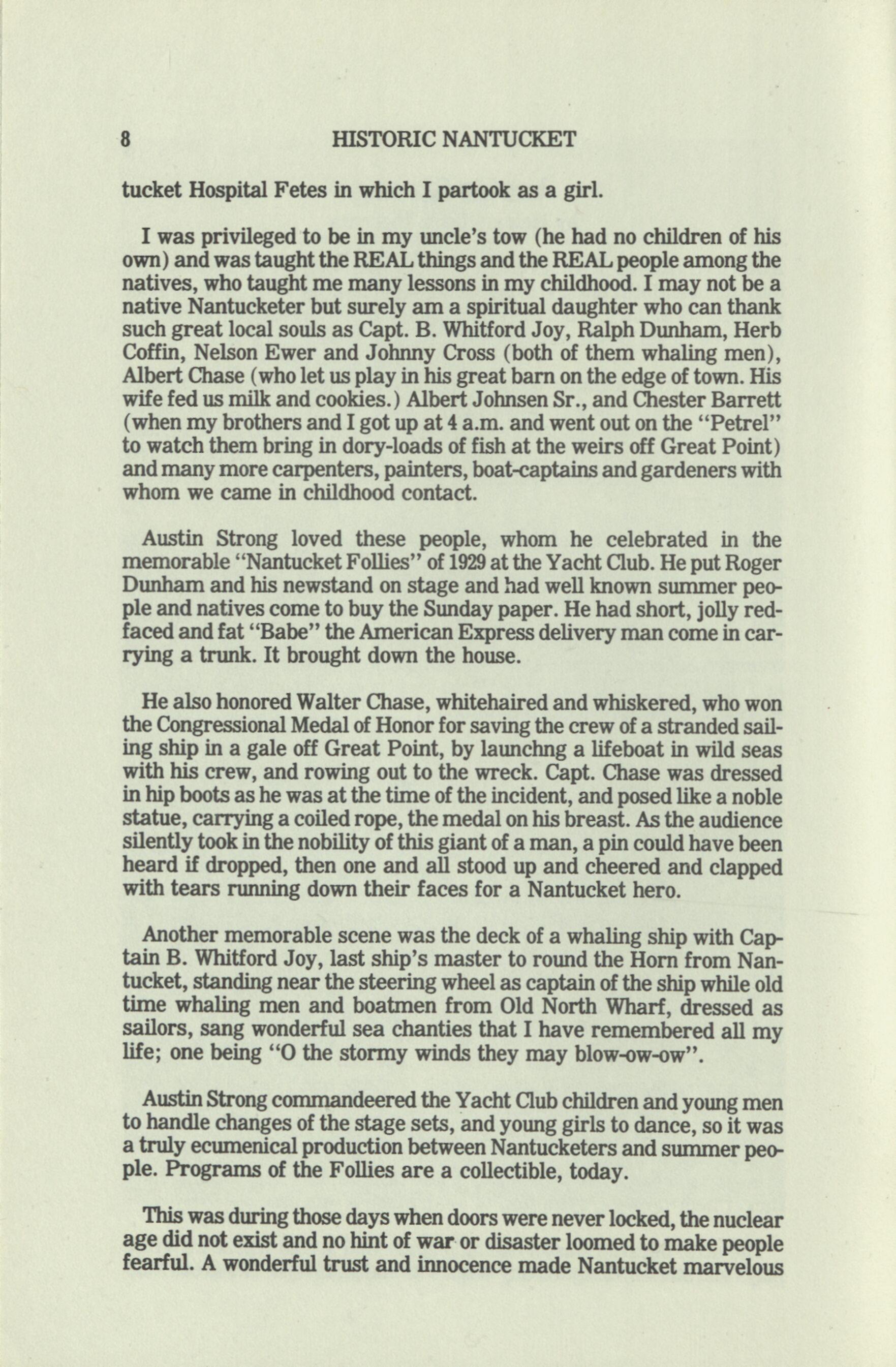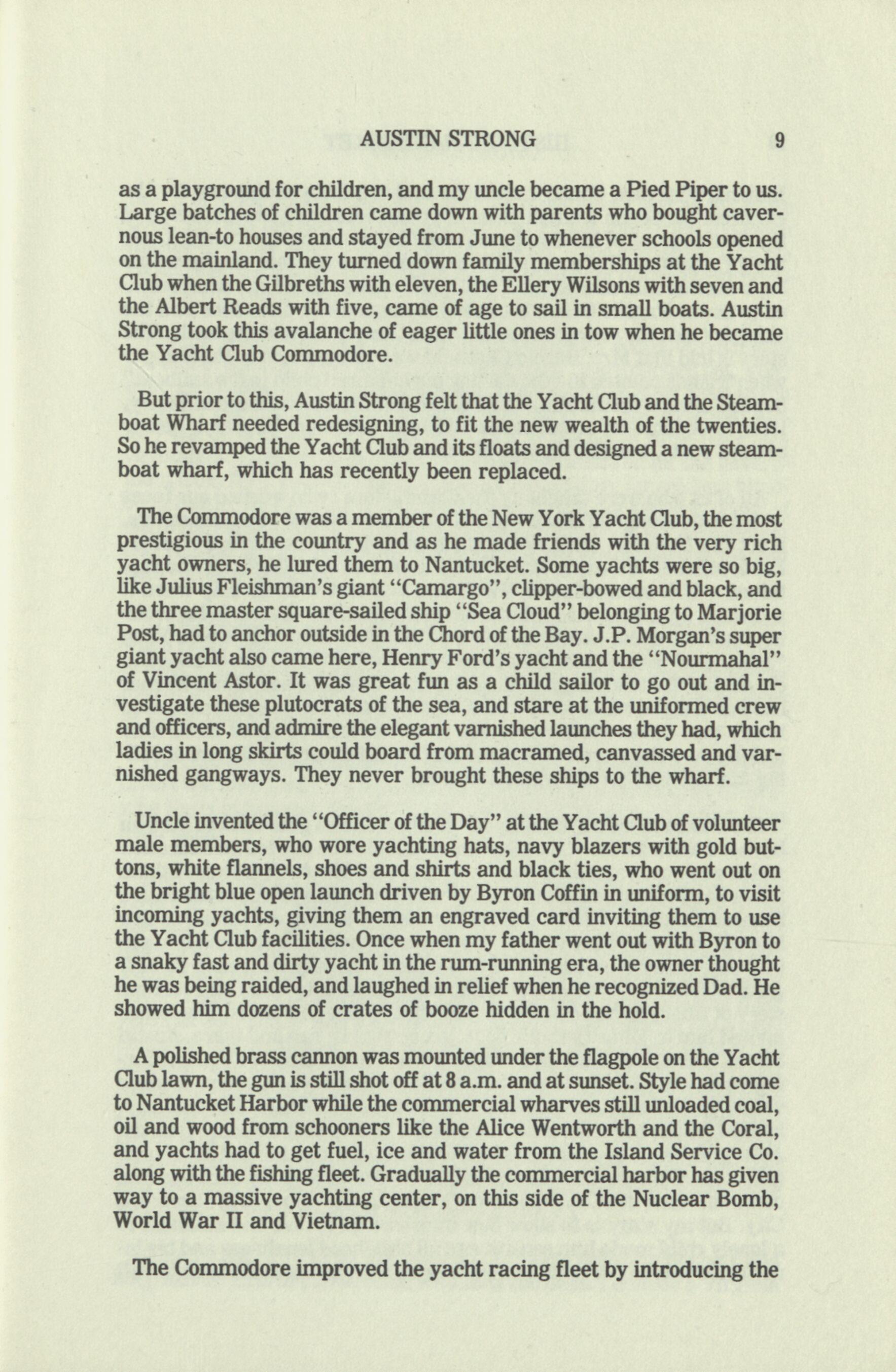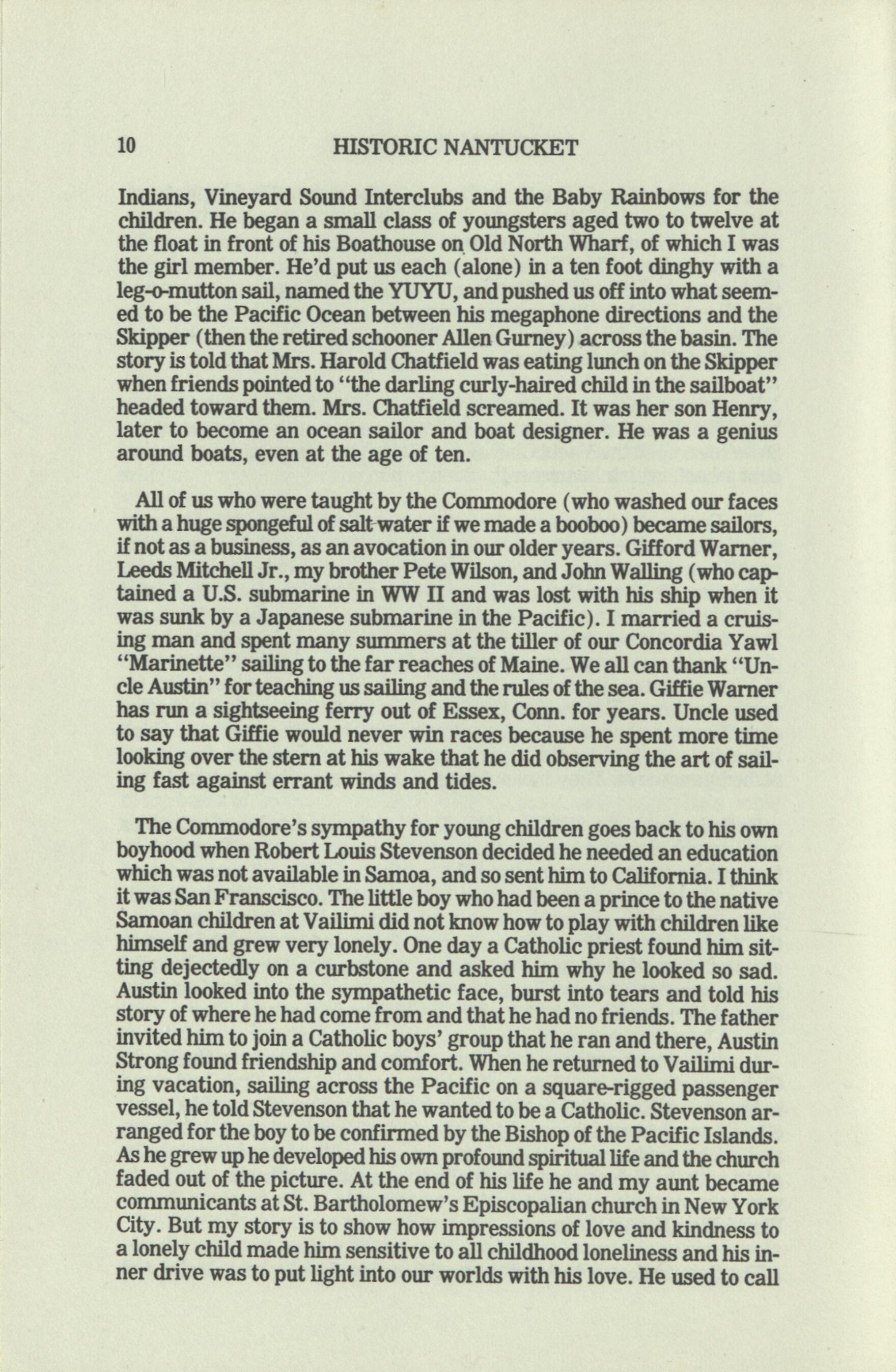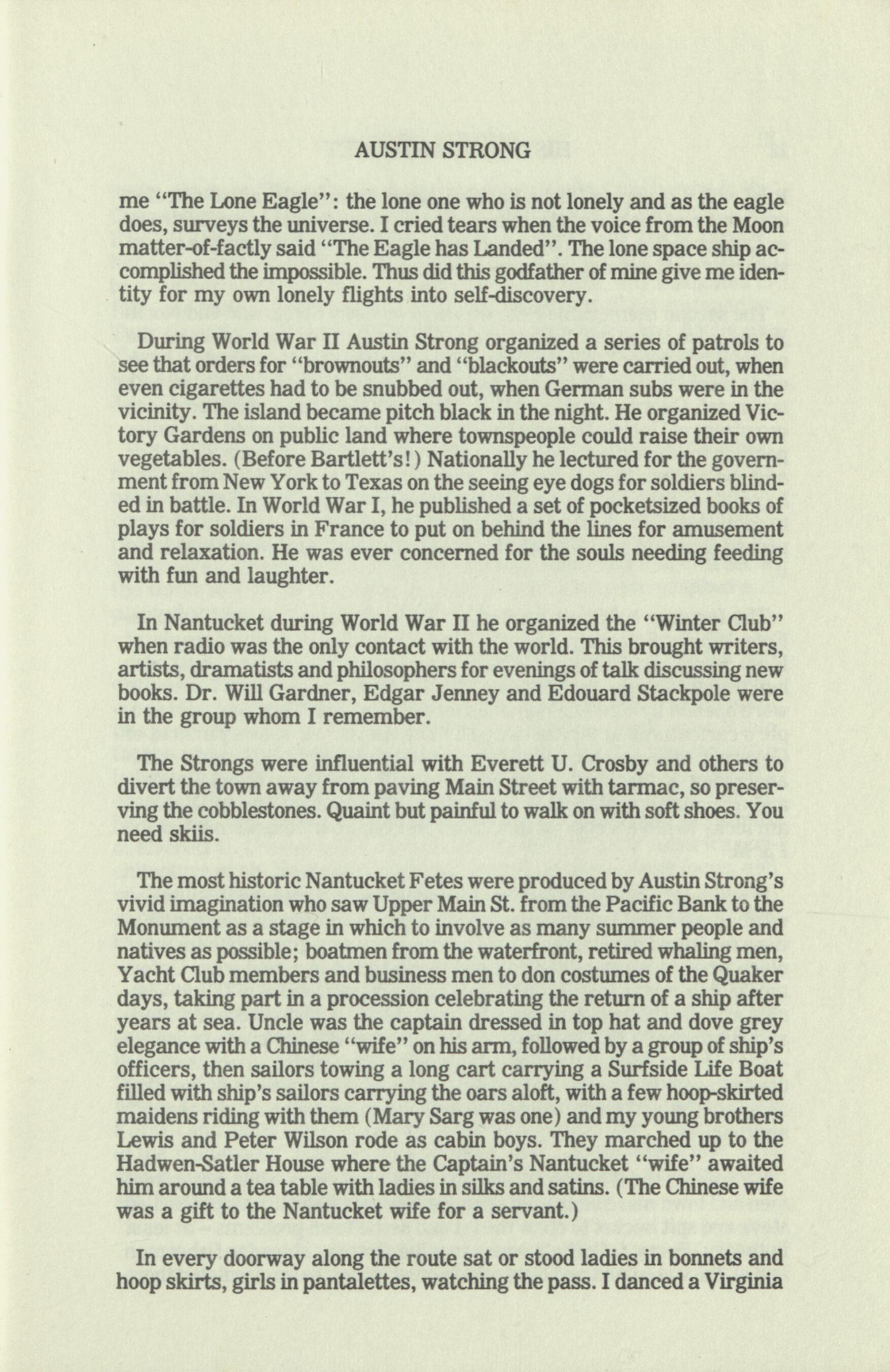
17 minute read
By Helen Wilson Sherman
Austin Strong
by Helen Wilson Sherman
7
AUSTIN STRONG WAS AN extraordinary man who brought Nantucket into the twentieth century. When new people flow into the scene without knowing its history, from the 1920's, and ask, "Who is Austin Strong?" it is time to set down what he did for this island.
He came from a glamorous and illustrious life which began as Robert Louis Stevenson's step-grandson, and evolved into a playwright, author, raconteur, as a man of letters with fame at his back, when he made Nantucket his stage set and created a new elegance here which celebrated (and still does) Nantucket greatness as a whaling port, before the stockmarket crash.
This dapper blue-eyed man, with smooth and shiny black hair and pink and white complexion, clean shaven, with heavy black eyebrows in his round face, had great style and charm. All of his delight in life was inspired by Stevenson. He loved pirates and Spanish galleons (influenced by Treasure Island). The old deviltry on the high seas, and buried treasure became artistic imaginings in which he dreamed of himself as THE CAPTAIN OF THE SHIP. In fact he acted it out on Nantucket, which became his buried treasure.
He first knew Nantucket when he married my father's sister, Mary Holbrook Wilson, and the couple visited the great house on the Cliff Road, south of the Sea Cliff Inn that my grandfather Ellery H. Wilson rented for the summer. It was around 1910. The island bespoke so strongly of the sea, in the romance of his dreams he knew that he had found with joy the place to create them and bring enchantment to the visiting population who had already bought houses here and came for the summer. He wanted to elevate the Nantucketer with a sense of its heritage for what was heavily asleep to their inheritance of silent heroism. He bought the 1731 house at 5 Quince Street after spying it from a horse and carriage, in a delapitated state of run down decrepitude. While my aunt sat in the carriage, Austin knocked on the door and asked the bushywhiskered unwashed, lanky man if the house could be bought. The man scratched his head and said he allowed it could. Uncle asked to see the attic and bounded up the stairs, took a look at the full-length empty room under the eaves and fell in love. The deal was made. (I remember the former owner whose last name escapes me. I used to see him in hip boots wading the shallows at the corner of Easy St. and Old North Wharf, spearing garbage into a hemp bag. His first name was Frank, a Nantucket neer-do-well, symptom of island loss of purpose.)
The attic became Austin Strong's study and studio where he wrote plays and stories, designed tiny stage sets and plotted the two great Nan-
8
HISTORIC NANTUCKET
tucket Hospital Fetes in which I partook as a girl.
I was privileged to be in my uncle's tow (he had no children of his own) and was taught the REAL things and the REAL people among the natives, who taught me many lessons in my childhood. I may not be a native Nantucketer but surely am a spiritual daughter who can thank such great local souls as Capt. B. Whitford Joy, Ralph Dunham, Herb Coffin, Nelson Ewer and Johnny Cross (both of them whaling men), Albert Chase (who let us play in his great barn on the edge of town. His wife fed us milk and cookies.) Albert Johnsen Sr., and Chester Barrett (when my brothers and I got up at 4 a.m. and went out on the "Petrel" to watch them bring in dory-loads of fish at the weirs off Great Point) and many more carpenters, painters, boat-captains and gardeners with whom we came in childhood contact.
Austin Strong loved these people, whom he celebrated in the memorable "Nantucket Follies" of 1929 at the Yacht Club. He put Roger Dunham and his newstand on stage and had well known summer people and natives come to buy the Sunday paper. He had short, jolly redfaced and fat "Babe" the American Express delivery man come in carrying a trunk. It brought down the house.
He also honored Walter Chase, whitehaired and whiskered, who won the Congressional Medal of Honor for saving the crew of a stranded sailing ship in a gale off Great Point, by launchng a lifeboat in wild seas with his crew, and rowing out to the wreck. Capt. Chase was dressed in hip boots as he was at the time of the incident, and posed like a noble statue, carrying a coiled rope, the medal on his breast. As the audience silently took in the nobility of this giant of a man, a pin could have been heard if dropped, then one and all stood up and cheered and clapped with tears running down their faces for a Nantucket hero.

Another memorable scene was the deck of a whaling ship with Captain B. Whitford Joy, last ship's master to round the Horn from Nantucket, standing near the steering wheel as captain of the ship while old time whaling men and boatmen from Old North Wharf, dressed as sailors, sang wonderful sea chanties that I have remembered all my life; one being "0 the stormy winds they may blow-ow-ow".
Austin Strong commandeered the Yacht Club children and young men to handle changes of the stage sets, and young girls to dance, so it was a truly ecumenical production between Nantucketers and summer people. Programs of the Follies are a collectible, today.
This was during those days when doors were never locked, the nuclear age did not exist and no hint of war or disaster loomed to make people fearful. A wonderful trust and innocence made Nantucket marvelous
AUSTIN STRONG
9
as a playground for children, and my uncle became a Pied Piper to us. Large batches of children came down with parents who bought cavernous lean-to houses and stayed from June to whenever schools opened on the mainland. They turned down family memberships at the Yacht Club when the Gilbreths with eleven, the Ellery Wilsons with seven and the Albert Reads with five, came of age to sail in small boats. Austin Strong took this avalanche of eager little ones in tow when he became the Yacht Club Commodore.
But prior to this, Austin Strong felt that the Yacht Club and the Steamboat Wharf needed redesigning, to fit the new wealth of the twenties. So he revamped the Yacht Club and its floats and designed a new steamboat wharf, which has recently been replaced.
The Commodore was a member of the New York Yacht Club, the most prestigious in the country and as he made friends with the very rich yacht owners, he lured them to Nantucket. Some yachts were so big, like Julius Fleishman's giant "Camargo", clipper-bowed and black, and the three master square-sailed ship "Sea Cloud" belonging to Marjorie Post, had to anchor outside in the Chord of the Bay. J.P. Morgan's super giant yacht also came here, Henry Ford's yacht and the "Nourmahal" of Vincent Astor. It was great fun as a child sailor to go out and investigate these plutocrats of the sea, and stare at the uniformed crew and officers, and admire the elegant varnished launches they had, which ladies in long skirts could board from macramed, canvassed and varnished gangways. They never brought these ships to the wharf.
Uncle invented the "Officer of the Day" at the Yacht Club of volunteer male members, who wore yachting hats, navy blazers with gold buttons, white flannels, shoes and shirts and black ties, who went out on the bright blue open launch driven by Byron Coffin in uniform, to visit incoming yachts, giving them an engraved card inviting them to use the Yacht Club facilities. Once when my father went out with Byron to a snaky fast and dirty yacht in the rum-running era, the owner thought he was being raided, and laughed in relief when he recognized Dad. He showed him dozens of crates of booze hidden in the hold.

A polished brass cannon was mounted under the flagpole on the Yacht Club lawn, the gun is still shot off at 8 a.m. and at sunset. Style had come to Nantucket Harbor while the commercial wharves still unloaded coal, oil and wood from schooners like the Alice Wentworth and the Coral, and yachts had to get fuel, ice and water from the Island Service Co. along with the fishing fleet. Gradually the commercial harbor has given way to a massive yachting center, on this side of the Nuclear Bomb, World War II and Vietnam.
The Commodore improved the yacht racing fleet by introducing the
10
HISTORIC NANTUCKET
Indians, Vineyard Sound Interclubs and the Baby Rainbows for the children. He began a small class of youngsters aged two to twelve at the float in front of his Boathouse on Old North Wharf, of which I was the girl member. He'd put us each (alone) in a ten foot dinghy with a leg-o-mutton sail, named the YUYU, and pushed us off into what seemed to be the Pacific Ocean between his megaphone directions and the Skipper (then the retired schooner Allen Gurney) across the basin. The story is told that Mrs. Harold Chatfield was eating lunch on the Skipper when friends pointed to "the darling curly-haired child in the sailboat" headed toward them. Mrs. Chatfield screamed. It was her son Henry, later to become an ocean sailor and boat designer. He was a genius around boats, even at the age of ten.
All of us who were taught by the Commodore (who washed our faces with a huge spongeful of salt water if we made a booboo) became sailors, if not as a business, as an avocation in our older years. Gifford Warner, Leeds Mitchell Jr., my brother Pete Wilson, and John Walling (who captained a U.S. submarine in WW II and was lost with his ship when it was sunk by a Japanese submarine in the Pacific). I married a cruising man and spent many summers at the tiller of our Concordia Yawl "Marinette" sailing to the far reaches of Maine. We all can thank "Uncle Austin" for teaching us sailing and the rules of the sea. Giffie Warner has run a sightseeing ferry out of Essex, Conn, for years. Uncle used to say that Giffie would never win races because he spent more timp looking over the stern at his wake that he did observing the art of sailing fast against errant winds and tides.

The Commodore's sympathy for young children goes back to his own boyhood when Robert Louis Stevenson decided he needed an education which was not available in Samoa, and so sent him to California. I think it was San Franscisco. The little boy who had been a prince to the native Samoan children at Vailimi did not know how to play with children like himself and grew very lonely. One day a Catholic priest found him sitting dejectedly on a curbstone and asked him why he looked so sad. Austin looked into the sympathetic face, burst into tears and told his story of where he had come from and that he had no friends. The father invited him to join a Catholic boys' group that he ran and there, Austin Strong found friendship and comfort. When he returned to Vailimi during vacation, sailing across the Pacific on a square-rigged passenger vessel, he told Stevenson that he wanted to be a Catholic. Stevenson arranged for the boy to be confirmed by the Bishop of the Pacific Islands. As he grew up he developed his own profound spiritual life and the church faded out of the picture. At the end of his life he and my aunt became communicants at St. Bartholomew's Episcopalian church in New York City. But my story is to show how impressions of love and kindness to a lonely child made him sensitive to all childhood loneliness and his inner drive was to put light into our worlds with his love. He used to call
AUSTIN STRONG
me "The Lone Eagle": the lone one who is not lonely and as the eagle does, surveys the universe. I cried tears when the voice from the Moon matter-of-factly said "The Eagle has Landed". The lone space ship accomplished the impossible. Thus did this godfather of mine give me identity for my own lonely flights into self-discovery.
During World War II Austin Strong organized a series of patrols to see that orders for "brownouts" and "blackouts" were carried out, when even cigarettes had to be snubbed out, when German subs were in the vicinity. The island became pitch black in the night. He organized Victory Gardens on public land where townspeople could raise their own vegetables. (Before Bartlett's!) Nationally he lectured for the government from New York to Texas on the seeing eye dogs for soldiers blinded in battle. In World War I, he published a set of pocketsized books of plays for soldiers in France to put on behind the lines for amusement and relaxation. He was ever concerned for the souls needing feeding with fun and laughter.
In Nantucket during World War II he organized the "Winter Club" when radio was the only contact with the world. This brought writers, artists, dramatists and philosophers for evenings of talk discussing new books. Dr. Will Gardner, Edgar Jenney and Edouard Stackpole were in the group whom I remember.

The Strongs were influential with Everett U. Crosby and others to divert the town away from paving Main Street with tarmac, so preserving the cobblestones. Quaint but painful to walk on with soft shoes. You need skiis.
The most historic Nantucket Fetes were produced by Austin Strong's vivid imagination who saw Upper Main St. from the Pacific Bank to the Monument as a stage in which to involve as many summer people and natives as possible; boatmen from the waterfront, retired whaling men, Yacht Club members and business men to don costumes of the Quaker days, taking part in a procession celebrating the return of a ship after years at sea. Uncle was the captain dressed in top hat and dove grey elegance with a Chinese "wife" on his arm, followed by a group of ship's officers, then sailors towing a long cart carrying a Surfside Life Boat filled with ship's sailors carrying the oars aloft, with a few hoop-skirted maidens riding with them (Mary Sarg was one) and my young brothers Lewis and Peter Wilson rode as cabin boys. They marched up to the Hadwen-Satler House where the Captain's Nantucket "wife" awaited him around a tea table with ladies in silks and satins. (The Chinese wife was a gift to the Nantucket wife for a servant.)
In every doorway along the route sat or stood ladies in bonnets and hoop skirts, girls in pantalettes, watching the pass. I danced a Virginia
12
HISTORIC NANTUCKET
Reel with a group on Phebe Beadle's lawn. Meanwhile, a two-wheeled cart drove at the end of the marchers carrying several severely dressed Quaker ladies, driven by a man in black with a top hat, going to sheepshearing as if nothing else was going on.
The second memorable Fete was held on Easy Street and Old North Wharf, also organized by my uncle. Governer Allen came over on the original "Naushon". The basin was filled with sailboats, their sails hauled at moorings, and flags and banners flew from every available pole and mast. George Grant, another "last" whaling man, climbed to the crosstrees of Uncle's flagpole beside his boathouse, and posed as a sailor pointing to whalespouts as he once did at sea, dressed in jeans, blue shirt and red and white neckerchiefs, barefoot, crying out "Ah-Blows!" as he pointed to the east. It was put on a postcard. That flagpole later had to come down. It was fifty feet high, and was Uncle's pride and joy, but proved unsafe in heavy winds. He used to fly giant American flags from it.
The Inquirer & Mirror printed a "Souvenir issue" of the "Hospital Fete, 1929 for Saturday, August 17" which is filled with photographs of Easy Street and Old North Wharf, where every shanty and boathouse had things for sale, food for sale (the best little neck clams I ever ate were opened by Red Haddon and Herb Coffin) and Tony Sarg did people's caricatures in the doorway of "The Annex". It shows pictures of Governor Allen and Miss Winslow, a delightful elderly lady, and a wideangle view of the whole basin with the sailboats, the original Skipper, and a windmill replica that was raffled off and ended up in Dionis. I am lucky to have a copy of this "Souvenir Number" supplement of the I & M.

It was as if with all of this great celebration of Nantucket both in her whaling past and her twenties present, set in motion future imaginations for island development in promoting her as a glamorous summer place where history added cultural background in a real way. Unfortunately for today, having suffered the depression and WW II and Vietnam and the H bomb, those wondrous times are not lived here any more and Nantucket's heydeys have become something we try to preserve - and does not add anything of today's culture and history, because there doesn't seem to be any. But Austin Strong had much to do in building up a faded island for it to continue to trade on as the twentieth century approaches.
He created the Wharf Rat Club on Old North Wharf when waterfront men and town merchants used to gather around Herb Coffin's pot-bellied stove and spit bucket to chew the fat and settle town problems - at least in theory. Perry & Coffin's was a marine clothing store for fishermen and all the waterfront and Nantucket Sound fishing news circulated there
AUSTIN STRONG 13
in the old days. When the Commodore of the Yacht Club bowed to the Commodore of the Wharf Rats (Herb Coffin) due to the motto NO RESERVED SEATS FOR THE MIGHTY, which my uncle created himself, a new era of blending summer people, politicians and VIPs into a wonderfully warm combination of give and take, was instigated in 1926, and nationally famous persons have Wharf Rat Flags designed by Tony Sarg flying from every sort of yacht, battleship and Arctic explorer. Franklin Delano Roosevelt came down in his schooner Amberjack and became a member. The Wharf Rat Club has been pictured and described in the National Geographic Magazine.
Meanwhile, with the rise of his three-storied Boathouse on this wharf in 1923, a new elegance appeared there which has evolved over the years until all the fishing shanties but one is now a summer rental and the commercial era of Old North Wharf has died. Robert Gambee's photographic essays on Nantucket have called the regal line of its Boathouses, "Nantucket's Venice", and the view from Easy Street of the water side of the buildings on pilings have been photographed and painted a hundred times over.
So one can readily see that a "Seeing Eye" from a creative and dramatic imagination by a man of letters with no idea of making money, out of his love for Nantucket, staged the dawn of its new era, in the twenties as a time of beauty, trust and honesty and style, which evolved into too many people wanting it. Its history from Austin Strong's initiative is being spoiled by too much money which has disturbed the island's economy. It is not the fault of my uncle's joy and sensitivity of the REAL Nantucket. The evolution of what he and many others started (I think of Everett U. Crosby and his study of 99% Perfect early American architecture of old Nantucket dwellings) is sliding out of their focus, and no Nantucketer today can make any local new history or culture, unhampered. It is survival of the unselfish real, unselfconscious art that is in jeopardy.

As the theme of this essay has been on one man's great influence in awakening Nantucket to itself from his gifts of imagination and appreciation, this does not cover Austin Strong's success as a playwright in New York and London. His stage play "Seventh Heaven" became the first motion picture to receive an award, 1927 (the Photoplay Medal) before the advent of the Oscars and became famous through Charles Farrell and Janet Gaynor. He wrote wonderful plays like "Little Father of the Wilderness" and "Drums of Oude" and "Three Wise Fools". He was a great Mime, besides. But he made Nantucket his greatest stage set, leaving the results for others to develop.







